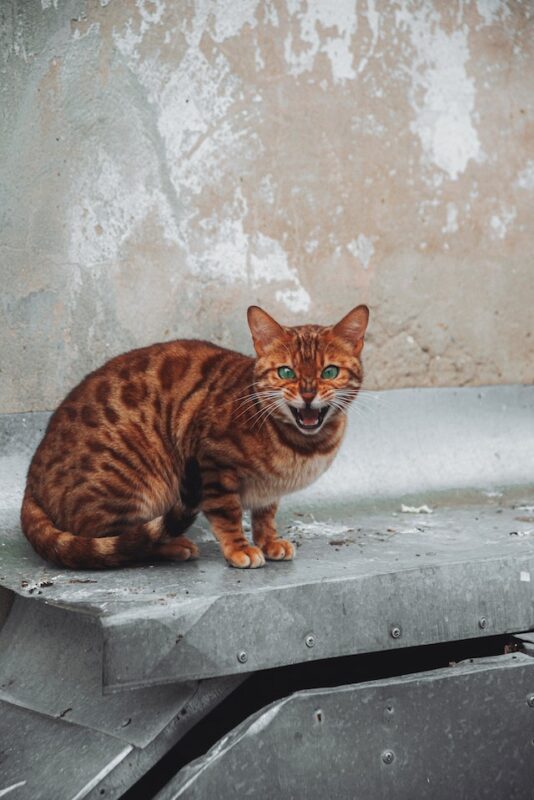What Causes Cat Aggression?
Posted: 05/23/2023 | BY: Jenna Bruce | Categories: Behavior , Cat , Top Tips
Cat aggression towards people is not as common as reported canine attacks. Having said this, some cats can become aggressive toward people and other pets, and this can become a frustrating and dangerous situation.
In this blog post, we’ll take a look at some of the most common reasons cats become aggressive and what you can do to mitigate this behavior to create a more harmonious home.
What is Cat Aggression?

Aggression is a natural response in all living things and one that is essential for survival. An aggressive response can be perfectly normal or abnormal, depending on the specific situation.
Aggression is technically a warning or blatant attack that is directed toward a person, another cat, or another animal. Cats become aggressive usually when they feel fear and threatened.
What Does Cat Aggression Look Like?
Aggression is a response to frustration, fear or anxiety, and sudden panic brough about by a perceived threat. In this aggressive state, a cat may hiss, growl, swipe or scratch at a person or other animal, and sometimes even use their teeth.
Current Science on Cat Aggression
There have been scientific studies to determine why cat aggression seems to occur in some cats and not others. And what we know is that intense prenatal stress exposure seems to result in a heightened sensitivity and reactivity. These kittens have a diminished ability to handle stressful situations and often grow up with abnormal levels of fear and, hence, unprovoked aggression.
One recent study found that in addition to early traumatic experiences, premature weaning can also increase aggression in adult cats. It looks like perhaps some hand-reared kittens may not learn how to handle frustrating situations, despite the well-intentioned loving human caretakers.
The 5 Main Causes of Cat Aggression and Effective Management Strategies
1. Fear

Some cats tend to be more frightened than others, and it seems this is caused by poor human socialization during the kitten period (2-8 weeks). Fear-based aggression is typically triggered by new people or situations. Bringing in a new pet or having a new pet sitter introduced may bring about unwanted aggression in some cats.
This kind of aggression can even happen when a pet parent handles a new, unknown cat, then handles his own cat. The scent of the unknown cat can absolutely trigger aggression toward the unsuspecting pet parent.
Cats that feel threatened by novel people, animals and situations will exhibit defensive behavior when approached. This behavior can include crouching, flattening their ears, and warning vocalizations such as growls and hisses. If the warning signs are not heeded and you or someone else decides to approach, scratching and biting may occur.
How to Manage Fear-Based Aggression
While your instinct may be to try and comfort your cat in this state, do not attempt to do so as you may become injured and your cat may become even more panicked.
Forced interaction with new people or pets should be avoided with these cats. Instead, be sure to supply numerous hiding spots for them to get away and feel safe. Combine these hideaways with structured interactions. Speak to your vet about desensitization techniques you may use to diminish their fearfulness over time.
2. Play/Predatory Aggression
Cats are notorious hunters. When they play, they mimic this hunting behavior. But sometimes this can be mistaken for aggression. For instance, your cat may suddenly pounce on you and quickly bat at your face. This behavior is usually a result of pet parents who play with their kittens using their hands. Kittens tend to get overstimulated, people laugh thinking it’s funny and never take steps to curb the behavior. And the cat grows up to “rough play” with their human who no longer finds it funny.
How to Manage Aggressive Play
When you cat ambushes you, try not to run from the play attack as it just reinforces their predatory impulse and response. Do your best to remain calm and never yell at or punish your cat.
If your cat is still young, avoid using your hands to rough play with them and instead redirect their energy into inanimate objects and toys. In general, try to have structured play more often with your cat using toys like wands.
3. Aggression During or After a Petting Session

Do you have one of those cats that becomes quickly overstimulated during a petting session and quickly lashes out by biting or scratching you? Some cats are fine being touched in certain areas, but when other areas, like their stomach, are touched, they lash out.
You must remember that your cat is not intentionally messing with you. She simply has deep, inborn survival mechanisms. While some cats will happily lay there and let their humans love on them all they want, other cats may have an internal conflict between pleasure and danger if they become too relaxed.
How to Manage Petting Aggression
Respect your cat and pay attention to her signs. How does she like to be touched? When does it become too much? The more you pay attention and respect your cat, the better your interactions will be.
4. Pain Induced Aggression
When cats are in pain due to an illness or injury, it is common for them to lash out with aggressive behavior. Even cats who are normally sweet and docile can become aggressive when they do not feel well. I think most humans can relate.
How to Manage
If your cat is normally not aggressive and they have begun to show a tendency, they may be in pain. It’s important to get them in to see the vet and checked out. They may have arthritis or something else going on that is causing them pain. A good pain management strategy should bring them relief.
5. Redirected Aggression

When a cat is feeling stressed or frustrated, they may redirect that frustration to something or someone else. What may cause a cat to feel this frustration in the first place? Perhaps seeing another strange cat right outside their window and they are unable to chase it off. If your cat is in a scuttle with another cat in the house and you pick him up in the middle, he may naturally redirect his aggression to you. Cats can get easily scared by loud noises. So you may be a target on July 4th when the fireworks are going off.
How to Manage
Do your best to keep your home free from loud noises. If you have brought a new cat into the home, you may need to keep your cats separated for some time before they can calmly and safely cohabitate with one another. If your cat tends to get agitated by other cats in the neighborhood, think about keeping shades lowered on windows or using opaque films on the windows to keep them from looking out.
Final Thoughts
As you can see, there are quite a few different reasons why cats may show aggression to you or another member of your family. Any sort of aggression can turn into a dangerous situation. Follow our guidelines to help redirect your cat’s energy. And if you think their aggression may be due to an illness or injury, get them in to see the vet right away.
How to Deal with Aggressive Vet Bills
No matter how hard we try to keep our cats healthy and happy, illness and injuries can happen suddenly and without warning. These can often lead to vet bills in the thousands of dollars. Are you able to afford those bills?
Pet health insurance will help you give your cat the very best care when they need it while also giving you peace of mind. Plans start at just $10 a month and some will even reimburse you for up to 90% of the bill.
Take a moment and get a free quote from one of the top pet insurance companies in the country.
References:
- Amat, M., Manteca, X., Brech, S. L., Ruiz de la Torre, J. L., Mariotti, V. M., & Fatjó, J. (2008). Evaluation of inciting causes, alternative targets, and risk factors associated with redirected aggression in cats, Journal of the American Veterinary Medical Association, 233(4), 586-589. Retrieved Nov 29, 2022, from https://avmajournals.avma.org/view/journals/javm
- Stelow, Elizabeth, 2022, Clinical Handbook of Feline Behavior Medicine pp 157, 9781119653271
- Bain, Melissa and Stelow, Elizabeth, 2014, “Feline Aggression Toward Family Members” Veterinary Clinics of North America: Small Animal Practice Vol. 44, No. 3, pp 581, 01955616
- Ilona Rodan, Chapter 1 – Importance of Feline Behavior in Veterinary Practice, Editor(s): Ilona Rodan, Sarah Heath, Feline Behavioral Health and Welfare, W.B. Saunders, 2016,Pages 2-11, ISBN 9781455774012, https://doi.org/10.1016/B978-1-4557-7401-2.00001-https://www.sciencedirect.com/science/article/pii/B9781455774012000015
- Aggression in Cats, Retrieved from: https://www.aspca.org/pet-care/cat-care/common-cat-behavior-issues/aggression-cats
Disclaimer
The information contained on this blog is intended for informational and educational purposes only and should not be construed as medical advice. It is not a substitute for professional veterinary care. Always consult with your veterinarian before making any changes to your pet's health care or treatment plan.
The authors of this blog are not veterinarians and do not claim to be experts in pet health. The information provided here is based on our own experiences and research, as well as information from reputable sources. However, we cannot guarantee the accuracy or completeness of this information.
We encourage you to do your own research and consult with your veterinarian before making any decisions about your pet's health.
Previous post
Should You Give Your Dog Coconut Oil?Compare top pet insurance providers plans.
Enter your dog’s age in years and months to calculate their age equivalent to human years.
Calculate your dog’s ageEnter your cat’s age in years and months to calculate their age equivalent to human years.
Calculate your cat’s age